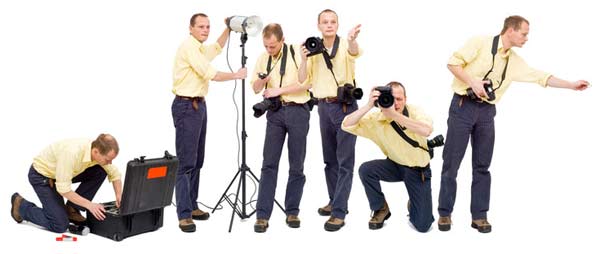Since being asked to moderate a panel at microstockexpo on workflow, I've been looking at more detail into what workflow means to different photographers. Workflow is essentially just business process, you perhaps can describe workflow as everything you do from image idea to image being for sale.
As a photographer you probably operate on a series of interwoven processes - whether you think it or not. Some processes are simple for a small business and done without thinking (and often don't need a formal process to be conceptualized). Procurement of new equipment, learning new skills, even quality control are often done through 'experience' without too much thought to what is actually taking place.
So why do some photographers seem to instinctively understand how to be successful while others diligently pour hours of work and creativity into making just enough money to 'get by'? There is a huge gap between selling microstock images and being successful at microstock.
When you start looking into workflow processes you soon realise what a broad subject it actually is, it's quite easy to apply to all parts of business not just tasks that are immediately associated with producing images.

Workflow Levels
The model I've presented below is loosely based on the CMMI model from Carnegie Mellon University, but you could apply one of numerous other business process systems (lean business / six sigma, ISO QA etc,) to your microstock work. This is not an actual business methodology to implement, but a series of levels you can measure yourself against. The processes you setup will be custom for your particular situation. Some time ago I wrote an example workflow but that only scratches the surface of what is needed. Don't look at this as extra work, doing this correctly will mean hours of savings and I personally think is a key difference between real success and mediocrity (and eventual failure due to lack of enthusiasm) in microstock.
I've presented this to highlight what I think is one flawed opinion that a lot of photographers share: that the final goal in microstock is taking images that sell regularly.

Level 1 Shooting - Taking photos, not as trivial as it sounds - need camera, internet, computer, capable of basic business administration - this is not a given, if you get rejected when you apply to a microstock agency, or have a high rejection rate this is where you currently are - the bottom: don't blame the agencies or the stiff competition, take a look at what you are doing wrong.
Goal: Baseline
Level 2 Technical Quality - acceptable images, at this level photographers focus on taking images that are technically good enough to be accepted, there is some limited focus on the choice of subjects and marketability, the bulk of microstockers I think are stuck at either this level or somewhere close to the next level. The majority of images generate zero sales in their first few months online.
Goal: 100% acceptance
Level 3 Consistent Selling - by this level the focus falls on producing images that sell consistently, technical aspects of image production are by this point fully under control. Measurement of previous success and failures to guide future subject choices plus analysis of in demand subjects. At this level there is a strong focus on a circular life-cycle of analyze, shoot, process, sell, and measure/react. A lot of microstockers feel that they are 'there' at this level: I think they're wrong.
Goal: 100% of images sell regularly.
Level 4 - Scaling and Profit, optimizing your work-flow to allow business to be efficiently scaled through outsourcing if needed. Management of costs to ensure that each photo is cost effective and can generate not just a profit but enough profit to continue to grow the business as needed. You can still operate as an individual at this level, but have a realistic understanding of equipment costs and the value of your time. Processes and responsibilities are defined in writing so that changes to any outsourced work can be efficiently communicated to another 3rd party company.
Goal: 100% of images recoup production costs, aggregate sales cover all business costs with some limited scope for investment.
Level 5 - Continuous Process Improvement, at this level the business is constantly on the lookout for new opportunities, investing in not just new equipment and training as need but also managing the current process efficiently. Monitoring and changing the process as and where needed to react to failures and external forces. Collaboration opportunities and (..I hate myself for actually writing this...) synergies are used to pool and build on strengths of related content creators and agencies.
Goal: Changes in the marketplace and technology are efficiently dealt with, minimal waste in production and supervision processes; investigation, analysis and reaction to current and future market changes.
I realise that there are people that take offense at the suggestion that 100% of images should turn a profit, it's perhaps more an idealistic target than something that is achievable. I also imagine there are plenty of photographers who are happy with a status-quo in that they make enough to live on but not grow their business until there is a need for them to earn more (more on that idea in how much can I earn from microstock).
I've got to be full-time to do all this yeah?
 No, this is not about being full-time or part-time. I know of several microstockers who work 20 or 25 hours a week, some who outsource shooting, processing and submission leaving them to concentrate on business admin, earning them more than the full-time paid salary. There is no reason that a part time shooter working 10 hours a week can't reach level 4, and I'm fairly certain there are people working 60+ hour weeks who are languishing at level 2.
No, this is not about being full-time or part-time. I know of several microstockers who work 20 or 25 hours a week, some who outsource shooting, processing and submission leaving them to concentrate on business admin, earning them more than the full-time paid salary. There is no reason that a part time shooter working 10 hours a week can't reach level 4, and I'm fairly certain there are people working 60+ hour weeks who are languishing at level 2.
There is only so much time you can save by working efficiently, eventually to scale a microstock business you will need either extra staff or outsource some tasks like keywording. This can be a difficult step to take, with concerns about quality control and for many a sense that they are letting go of what they currently have complete control over. Outsourcing is not always the best option, sometimes are very custom approach is needed, and the only solution to growth would be to employ and train someone in-house.
Hopefully this post will help you think more clearly about your current direction as a stock photographer, and if you have not already done so realize the 'bigger picture' that is a microstock business. What you do and the time you spend impacts on your success and indeed your lifestyle and how much you enjoy your work. The single thought I will leave you with is that it is absolutely not necessary to feel that you have to work alone to make ends meet in microstock - the microstock secret for many photographers is outsourcing to someone who can do some of the work better and at a lower cost.
What level are you at?
Related Posts:



It's quiet in here! Add new comment